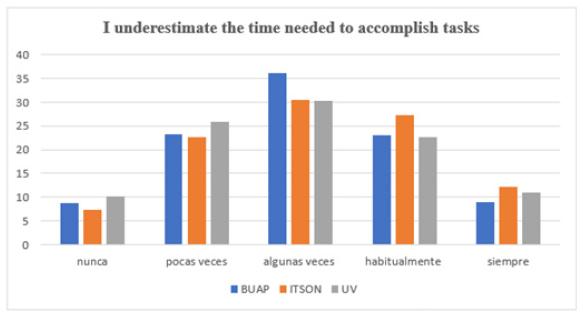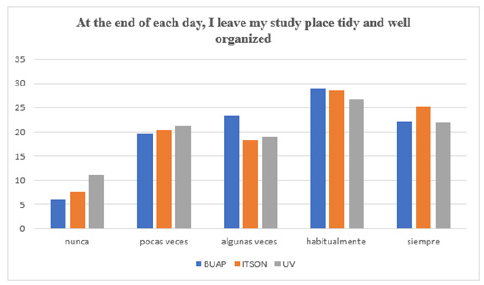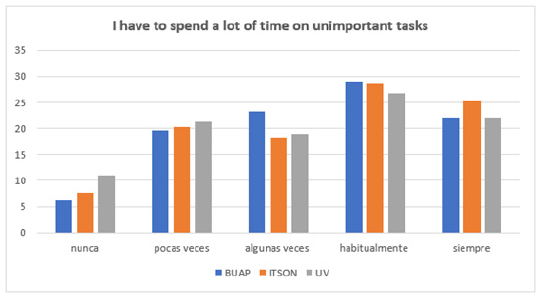- Submissions

Full Text
COJ Reviews & Research
Time Management Profile of Students in Different Universities
Vera Cervantes E Erica* and Navarro Rangel Yadira
Meritorious Autonomous University of Puebla, Mexico
*Corresponding author:Vera Cervantes E Erica, Meritorious Autonomous University of Puebla, Mexico
Submission: August 10, 2022; Published: August 25, 2022

ISSN 2639-0590Volum4 Issue2
Summary
This study focuses on describing the profile of time management of students from three different universities: Benemérita Universidad Autónoma de Puebla, Instituto Tecnologico de Sonora and Universidad Veracruzana, through the evaluation of psychometric characteristics of the Time Management Behavior Questionary (TMBQ). Data collected from 1831 students from 25 different universities were used. The time management dimensions show a preference for setting goals and priorities for the three universities. With all this, we facilitate the development of intervention proposals for the improvement of time management skills.
Introduction
Research focusing on time management in university students has shown that time management is associated with academic management [1-7]. Time management becomes very important because it helps to prioritize activities to be carried out and thus determine which ones require more or less time. A greater number of activities would be carried out when we know how much time we have in our hands. Knowing what we will work on, when and how much time we must finish, increases our productivity, which guarantees that we will get more quality in what we are doing. As time is scarce it must be administered properly. In organizations actions are planned to meet con schedules of activities, in the case of students the proper management of time will allow them to complete their tasks properly, have everything in order, since staying organized is key to maintain concentration in the study, it is a good lesson for life, the study is facilitated, they will be able to improve their grades, detect problems, schedule time for sport or other activities and eliminate stress. However, we face the problem where students don’t practice that habit of managing their time. Naturil in its research concludes “We can indicate that university students tend to procrastinate, regardless of the time they have for the preparation and delivery of the task. Thus, those students who postpone the completion of the task until the final period of the classes significantly reduce the time they can devote to the preparation of the final exams. Therefore, the process remains a problem that affects the university student, which requires that measures must be taken for proper planning and work habits throughout the course that allow to improve the results” [8]. The results obtained by Ruíz and Zavala [4]. are summarized in that most of the students recognize that with better time management they would improve their academic performance, keep their balanced schedule and their time administered can make the difference in a high note to a low. In this paper we will analyze the time management profile of students from three different universities: Benemérita Universidad Autónoma de Puebla, Instituto Tecnologico de Sonora and Universidad Veracruzana, using the psychometric characteristics of the Time Management Behavior Questionary (TMBQ) so that according to the results, we can develop activities, courses and workshops that allow to support the student to manage their time..
Method
This study is descriptive, where there was a total of 1831 answers, collected through a questionnaire. Of the total, 854 students were from the Benemérita Universidad Autónoma de Puebla, 469 from the Instituto Tecnologico de Sonora and 508 from the Universidad Veracruzana from the following careers: Administration, Tourism Administration, Computer Science, Communication Sciences, Education Sciences, Electrical Engineering Sciences, Child Development, Education, Physical Education, Early Childhood Education, Electronics, Nursing, Computer Science Engineering, Electromechanical Engineering, Electronics Engineering, Renewable Energy Engineering, Mechatronics Engineering, Automotive Systems Engineering, Informing Technology Engineering, Mechanical Engineering, Educational Mathematics, Pedagogy, Psychology, Computer Systems and Environmental Science Engineering. Students from 18 to 29 years old participated, with an average of 19.41 and a deviation of 2.96, of these, 650 were women (35.49%) and 1181 men (64.50%). On the other hand, the predominant careers are Mechatronics Engineering, for the Benemérita Universidad Autónoma de Puebla and the Instituto Tecnologico de Sonora, and Administration for the Universidad Veracruzana.
An instrument was used for the evaluation of time management called Time Management Behavior (TMB) where the version of Macan, Shahani, Dipboye and Phillips (1990) proposes an adaptation of this same and calls it Time Management Behavior Scale (TMBQ). It has w34 items and uses a Likert scale, where 1 represents “never” and 5 represents “always”. It is reorganized and results in the following 4 dimensions: Establishment of objectives, priorities, tools for time management, preference for disorganization and perception of time control, which are defined by the authors as follows:
Setting goals and priorities
Involves the predisposition to select and prioritize the tasks that the individual needs to do to achieve their goals. This consists of 10 items -1, 5, 7, 9, 13, 17, 21, 24, 27 and 31-.
Tools for time management
Refers to the use that the subject makes of the behaviors usually associated with effective time management, such as techniques where a schedule is planned, list to discard tasks performed, use of agenda. This consists of 11 elements -3, 6, 11, 14, 18, 22, 25, 28, 32, 33 and 34-.
Preferences for disorganization
Consists of the ways in which the subject approaches their tasks and the maintenance of a planned study environment. This consists of 8 items -2, 8, 12, 16, 20, 23, 26 and 30-.
Perception of control over time
Refers to the degree to which the subject’s perceptions of time control directly affect the way he uses it. This consists of 5 items, - 4, 10, 15, 19 and 29-.
The procedure consisted of applying the questionnaire to the university students of the different careers which is divided into two parts, the first part collects the data of the students, such as enrollment, career, sex, email, average, state civil, age and institution and the second collects the items according to the previous dimensions and with response in Likert scale. The Cronbach’s alpha test was performed to verify the validity of the construction of the items and then the results are analyzed. All this through the SPSS 21.0 program.
Analysis
The instruments of measurement of the constructs must demonstrate that their scores in the sample with which they are working have the psychometric properties of validity and reliability [9]. Therefore, the Cronbach’s Alpha test is performed to measure the effectiveness of the instrument for each of the dimensions. Cronbach’s alpha is the most used statistic in articles as a means of estimating the internal consistency of scores for a set of items [9]. This measurement requires the results of the sample with which we work, that is, the scores given by the respondents for each of the items. Thus, we found the consistency in the measurement of each of the factors according to the responses of the students at the different universities. For the Benemérita University of Puebla we found a value of 0.785 for setting objectives and priorities, for tools for time management 0.760, for preferences for disorganization 0.501 and for perception of control over time 0.259. For the Technological Institute of Sonora, we find a value of 0.766 for the establishment of objectives and priorities, for tools for time management 0.787, for preferences for disorganization 0.467 and for perception of control over time 0.351. For the Universidad Veracruzana we found a value of 0.796 for setting objectives and priorities, for tools for time management 0.778, for preferences for disorganization 0.534 and for perception of control over time of 0.248. With this we verify the reliability of the scale scores in the sample, that is, we confirm the strength of the TMBQ to evaluate the way in which students manage their time.
Result
Once the statistics have been analyzed and verifying that the selection of items adequately explains the time management in the students, we proceed to interpret the results. We do not see that there is a similar behavior within the three universities, that is, the same level for each of the dimensions. It should be noted that, although it can be thought that there is no positive correlation between universities (given all the variables that influence a student from one state to another) they have very similar characteristics. If we look at the correlation of factors between universities, we can see that this is relatively small, not exceeding 0.50 the value of the correlation coefficient [10] they write suggested recommendations for each score in each factor and by the combination of these. We carry out an analysis by academic average of each student and relate it to the score of the factor, obtaining the following (Table 1). Averages were rounded to be able to compare the respondents with whole quantities and make the analysis of the data easier. Of the total number of students surveyed, we will look at those who obtained an average of 70, where 3.61% have a score of 41 to 50, and according to the suggested recommendations, these students should “Continue to make good use of those behaviors usually associated with effective time management, such as techniques where you plan a schedule, list to discard tasks performed, use of agenda among others”. For the 48.19% who added 31 to 40 points, the following is described: “Continue to make use of behaviors usually associated with effective time management, such as techniques where a schedule is planned, list to discard tasks performed, use of agenda among others, but that you can even improve.” For the 45.78% who added 21 to 30 points, the following “You are making intermittent use of behaviors usually associated with effective time management, such as techniques where a schedule is planned, listed to discard tasks performed, use of agenda among others, but that you can still improve; if you require support, you must consult your guardian.”For 2.41% and 0.0% from 11 to 20 and from 0 to 10, respectively, the following “You are making inappropriate use of behaviors usually associated with effective time management, such as techniques where a schedule is planned, listed to discard tasks performed, use of agenda among others, but that you can still improve; if you require support you should consult your tutor” and “You are making inappropriate use of behaviors associated with effective time management, where you do not plan a schedule, or use lists for activities or to discard tasks performed, or a use of agenda among others, but that you can improve; you should consult your tutor or review your academic possibilities”. In a more general perspective, we notice that for factor one, which talks about setting goals and priorities, a large part of the students does use of behaviors usually associated with effective time management, such as techniques where a schedule is planned, listed to discard tasks performed, use of agenda among others, but that can still improve (Table 2). For factor two, most students need to increase considering the predisposition to select and prioritize tasks they need to achieve their goals. In factor three we observed that scores from 17 to 24 predominate, and according to the text, these students are recommended a substantial improvement to address their tasks, as well as the maintenance of a planned study environment. Finally, in the factor four most of the students are placed in a range of 11 to 15, and according to the text [10]. These students require considerably perceive in a better way their control of time, which directly affect the way of how they use it. Table 3 shows the percentages of students by sum of factors. With this we also realize that there is no notable trend within the sums of the scales [11-13]. It is a principle you could think that at higher averages students usually have better scores in each factor, that is, better time management as well as better organization of their activities, however, this is not the case (Table 4). If we look at the average of the scores by university, we can see that all show a similar trend, having differences of no more than three points. This means that, despite being students from other states, the distribution of time is usually similar. It is important to highlight the difference of the BUAP students in the aspect that a higher percentage underestimate the time needed to complete the tasks of their studies, unlike the other universities (Figure 1). In the case of the Organization of activities at least one week in advance, the Universidad Veracruzana shows a higher percentage, so it can be ensured that most of the students at this university organize their activities in advance (Figure 2). The Figure 3 shows that the BUAP reflects that most students leave their place of study tidy and well organized. The Figure 4 shows that the students of the three universities reflect that they spend a lot of time on unimportant tasks.
Table 1: Scores by average factor 1.

Table 2: Percentage of scores by factors.

Table 3:Average factors by university.

Table 4: Average factors by sex.

Figure 1: Underestimate the time needed to accomplish tasks.

Figure 2: Organize activities at least a week in advance.

Figure 3: At the end of each day, I leave my study place tidy and well organized.

Figure 4: I must spend a lot of time on unimportant tasks.

Conclusion
Carrying out this comparison is extremely useful because it allowed us to know the time management habits of students from three different universities and to realize that we can work to generate study activities, support activities and time management strategies that allow us to help students and at the same time universities to increase academic performance.
References
- García Ros R, Pérez González F, Talaya González I, Martínez Díaz E (2008) Analysis of the management of academic time of new students in the psychology degree: Predictive capacity and analysis between two evaluation instruments. Conference proceedings Infad 2(1).
- Jianzhong X (2010) Prediction of homework time management at the secondary school level: a multilevel analysis. Individual Learning and Differences 20(1): 34-39.
- Durán E, Pujol L (2013) Learning styles, time management and academic performance in university students. Simón Bolívar University. Valle de Camurí Grande Edo.
- Ruíz M, Zavala C (2013) Lack of time management as a contributing factor to poor school performance in USA Students. Electronic Journal in Social Sciences and Humanities Supported by Technologies 2(1): 92-98.
- Martinic S, Villalta M (2015) The management of time in the classroom and school performance in full-time schools in Chile. Educational Profiles 37(147).
- Pillars RP (2017) Time management and academic performance of economics students case: Universidad Andina del Cusco, 2016.
- Garzón A, Gil J (2018) Time management in university students with different levels of academic performance. Faculty of Education of the University of São Paulo. Education and Research 44: e157900.
- Naturil C, Peñaranda D, Salvador J, Jiménez FM (2018) Procrastination: the poor time management among university
Students.
- Frías-Navarro D (2021) Notes of internal consistency of the scores of a measuring instrument.
- UV-CA-278 (2014) Innovative learning environments. LGAC: Culture, Technology and Educational Mediation: Simulation in Virtual Learning Environments (VPA): Didactic strategy for the development of generic competences in university students.
- Durán Aponte E, Pujol L (2013) Management of academic time in young people who begin studies at the Simón Bolívar University. Latin American Journal of Social Sciences 11(1): 93-108.
- Mondragón C, Cardoso D, Bobadilla S (2017) Study habits and academic performance. Case studies of the degree in Administration of the Tejupilco Professional Academic Unit, 2016. Autonomous University of the State of Mexico.
- Reyes N, Meneses AL, Díaz A (2022) Planning and management of academic time of university students. Form Univ 15(1).
© 2022 Vera Cervantes E Erica. This is an open access article distributed under the terms of the Creative Commons Attribution License , which permits unrestricted use, distribution, and build upon your work non-commercially.
 a Creative Commons Attribution 4.0 International License. Based on a work at www.crimsonpublishers.com.
Best viewed in
a Creative Commons Attribution 4.0 International License. Based on a work at www.crimsonpublishers.com.
Best viewed in 







.jpg)






























 Editorial Board Registrations
Editorial Board Registrations Submit your Article
Submit your Article Refer a Friend
Refer a Friend Advertise With Us
Advertise With Us
.jpg)






.jpg)














.bmp)
.jpg)
.png)
.jpg)










.jpg)






.png)

.png)



.png)






